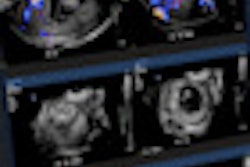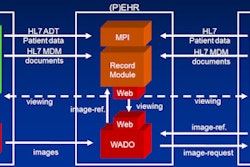
MINNEAPOLIS - The field of imaging informatics has witnessed key advances in business intelligence, advanced visualization, storage, digital radiography, and reporting over the past year, according to presentations in the opening session of the Society for Imaging Informatics in Medicine (SIIM) annual meeting.
Business intelligence
The past year has brought anxiety and pressure to professionals in the healthcare and medical imaging fields, but it has also created vast opportunity, according to Raymond Geis, MD, of Advanced Medical Imaging Consultants in Fort Collins, CO.
Anxiety and pressure stem from the unsustainable costs of healthcare in the U.S., which have prompted efforts to rein in costs and reform the system. Another option in favor in Washington, DC, to tackle healthcare cost is "episode of care" bundled payments (including both hospital and physician payments), Geis said. Five demonstration sites are currently under way to test this concept. Accountable care organizations (ACO) are also being examined.
Competitive pressures are also building, as competition is now national and regional rather than local. No business is immune, Geis said.
"This past year, three very prominent and large radiology groups lost their contracts to national firms," he said.
The data deluge mentioned at past SIIM conferences is also a challenge radiology practices continue to face.
New opportunities
However, there is also increasing opportunity, Geis said. The American Recovery and Reinvestment Act (ARRA) stimulus funding will invest $27 billion in healthcare IT to reform healthcare. Money will be provided to physicians and hospitals that are successful in becoming "meaningful users" of certified electronic health record technology, Geis said.
Also, despite the tough economic environment, 52% of hospitals increased their healthcare IT budget in the fourth quarter of 2009, he said.
Imaging informatics can play a huge role in providing business intelligence, according to Geis.
"What we want to do is find a way to collect accurate data -- and see patterns in those data -- to provide better quality for the patients, drive efficiency, and plan for our futures," he said. "This is a whole new world for imaging informatics, and one that offers a lot of opportunity for us."
In the future, gross payments will be based on patient data. Net payments will be based on data about the practice, Geis said.
"Innovations that increase value will be strongly rewarded," he said. "It's a big opportunity and [also] a daunting task."
3D
One of the biggest trends in 3D over the past year has been the growing power of thin-client software, said Bradley Erickson, MD, PhD, of the Mayo Clinic in Rochester, MN.
"For many years, we've had thin clients that could do basic visualization; they could pop up pretty pictures," he said. "But in terms of doing actual clinical applications, they were often much more limited [than traditional thick-client 3D software]. In the past year, we've seen thin clients that can truly actually start to replace the thick clients."
Thin clients can also now perform quite well on low-end hardware such as iPads and laptops, as well as work better on networks with low bandwidth and high latency, Erickson said.
3D software has also benefited from a higher level of workflow support within the application, Erickson said. Although improvements have been made, there is still insufficient support for workflow with other departmental systems such as RIS and PACS, however.
In other trends, reporting functionality has also been improved within 3D applications, including support for 2D image viewing. In addition, there is increasing support for reporting, most often in a structured reporting format, Erickson said.
3D software is also being utilized more on mainstream hardware, he said. Vendors are increasingly utilizing acceleration based on graphics processing units (GPUs) rather than on special-purpose processors.
Much more flexibility in purchasing options is also now available, Erickson said.
3D is also being used in an outsourcing or co-sourcing model, he said. Several large teleradiology firms are providing 3D as part of their service offerings. 3D processing/preparation is also being offered as a service.
Erickson suggested that SIIM attendees ask vendors about their views on the role of PACS versus 3D software. These systems are now encroaching on each other, as PACS are increasingly adding 3D capability and 3D software is incorporating more and more PACS workflow functionality, Erickson said.
Also, he recommended querying vendors on how to integrate their 3D software with a RIS and image interpretation worklist to improve efficiency.
Storage
Cloud computing has been particularly promising in the past year, particularly as it relates to the problem of image sharing, said Keith Dreyer, DO, PhD, of Massachusetts General Hospital in Boston.
Cloud computing, which employs Internet-based servers for processing, storage, and secure transmission, offers a number of advantages. It provides simple and secure cross-enterprise communication, and it comes with lower capital and operating costs, Dreyer said.
Because it's Internet-based, cloud computing can also provide immediate upgrades, multiple supported platforms, and automatic remote access for radiologists, referring physicians, and even patients, Dreyer said.
Cloud computing may also help resolve the challenges in today's radiology practice related to physical transmission of images via CDs or DVDs, he said.
"Now we have different ways to get to those physicians who are outside of our network and to get their information from other hospitals that are referring patients and patient data," Dreyer said. "Patients can receive and send us data, as well."
Digital radiography
Digital radiography (DR) has witnessed a number of new trends in the past year, according to Anthony Seibert, PhD, of the University of California, Davis Medical Center.
Portable, wireless DR detectors are increasingly becoming available with the form factor of traditional film-screen cassettes, Seibert said.
"That means that these vendors are providing the technologies that can simply replace existing film-screen systems with a fully robust and very useful imaging system that's digital," Seibert said.
Point-of-service DR imaging is now possible, with image acquisition, processing, and display performed bedside or in the operating room, for example.
DR retrofits are also being performed to existing analog x-ray and older computed radiography (CR) rooms. As a result, many traditional CR vendors have added thin-film transistor (TFT) flat-panel-based DR offerings to their product lines, Seibert said.
And it's not just static projection imaging that is experiencing technology gains. Flat-panel digital detectors now support fluoroscopy and fluorography, he said.
Digital tomosynthesis is bringing these detectors into the 3D space, and CT conebeam acquisition is showing particular promise in interventional radiology, Siebert said. With these technology advances come more images, more processing, and more storage requirements, however.
"Hanging protocols are going to be really important, so that we can get that information in a very efficient way," he said.
Radiation dose from medical imaging procedures became a hot-button issue in 2010, and developments are under way to address this important issue.
A standardized dose index has been created by the American Association of Physicists in Medicine (AAPM) and the International Electrotechnical Commission (IEC), providing an international standard for all CR/DR vendors. This provides a unified method of applying and reporting exposure index values, and it assists technologists in providing feedback to reduce patient exposure, he said.
Also, the Image Gently campaign for pediatrics is an initiative to "kid-size" the target exposure index value. An Image Wisely campaign is also moving forward for adults, Seibert said.
In addition, the Integrating the Healthcare Enterprise (IHE)'s Radiation Exposure Monitoring (REM) profile can come in handy, he said.
Communication
Despite years of discussion, the vision of the multimedia imaging report -- which uses all available data and media in creating and distributing imaging information -- is still yet to be realized, said David Weiss, MD, physician coordinator of imaging informatics at Carilion Clinic in Roanoke, VA.
Many of the resources that could be utilized in these multimedia reports are not being used at the current time, Weiss said.
"I like to think about a reporting-centric workflow and like to think about my reporting system as more than just a microphone and a transcription service," he said. "It should be a communication information system; it should handle a lot of different things."
By Erik L. Ridley
AuntMinnie.com staff writer
June 3, 2010
Copyright © 2010 AuntMinnie.com



















